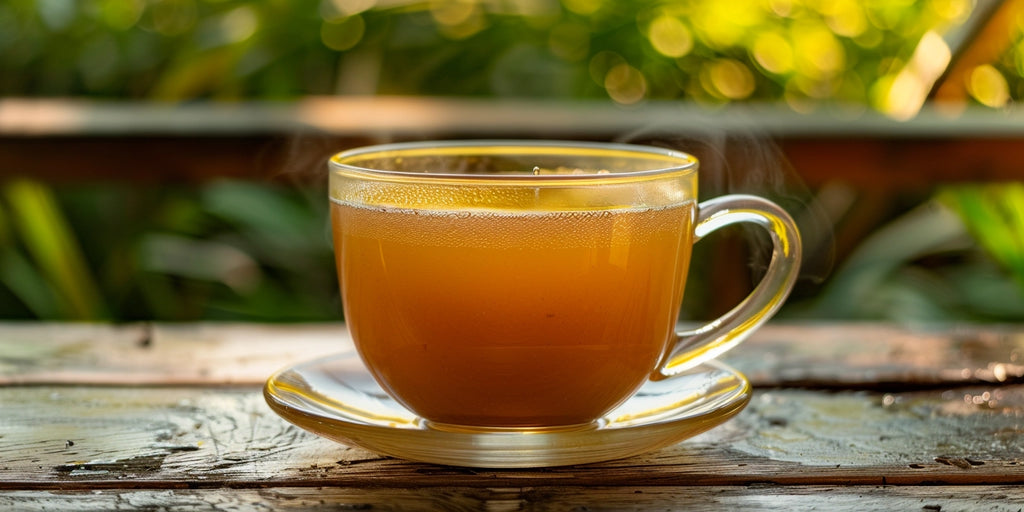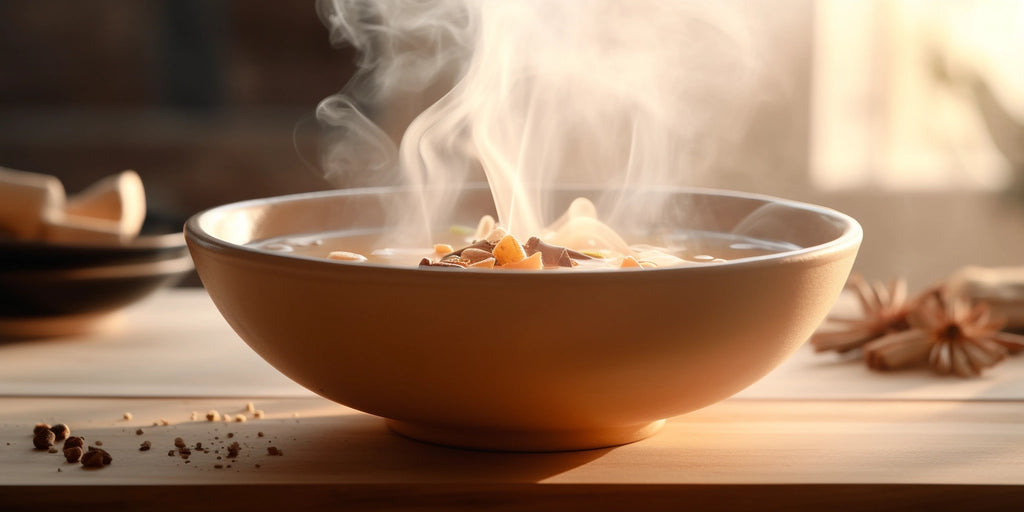Have you ever considered initiating your day with a cup of bone broth? The concept is not exclusively for cold winter evenings anymore. We're here to enlighten you about the significant benefits of consuming bone broth at breakfast and why mornings are an ideal moment to adopt this nutritious habit.
Consuming bone broth immediately after waking provides your digestive system with a beneficial boost. It's packed with vital nutrients that your body can effortlessly absorb, making it an excellent choice for daily gut health. What makes it even more appealing? The ability to enhance your bone broth by incorporating delicious ingredients such as onion, celery, carrot, parsley, thyme, and garlic. Regardless of whether it's beef, chicken or lamb - one can create a batch of bone broth utilizing bones and connective tissues from different animals.

Benefits of Bone Broth
By now, we've all heard the adage of starting our morning with a hot cup of bone broth. So, what's the big deal about bone broth, you may ask? Well, we're here to delve into the nuts and bolts of this gut health boon.
Bone broth is no ordinary brew; it's chock-full of essential nutrients that are conveniently bioavailable. This means our body can readily absorb and utilize these nutrients, kick-starting those sleepy morning body processes. To top it off, the nutrients are easily digested, which means it's less stressing on your system and makes it an excellent choice for your daily gut-health ritual.
Imagine greeting the day with a nutritious liquid that not only warms your body but also sets your digestive system into action! Yes, drinking bone broth in the morning does just that. It's the perfect all-year-round morning beverage that eases your system and primes it for the day.
For those of us who cherish a mindful morning at home, sipping bone broth at the break of the day can become a wellness ritual. Flavors like Lemon, Ginger, and ACV (Apple Cider Vinegar) add an aromatic and tangy kick to our regular bone broth. A concentrated broth infused with these flavors can transform your morning routine into an experience of daily self-care.
Like any choice in life, timing is key. Drinking bone broth for breakfast is ideal as it helps jumpstart our digestive system lightly and healthily. This smooth start helps our bodies absorb and utilize the nutrients consumed throughout the day more effectively.
How to Make Bone Broth
The process of preparing bone broth has a rich history and is relatively simple, but it requires patience. The result is a flavorful, nutrient-packed concoction that can be added to a variety of dishes or enjoyed on its own. Our recipe focuses on beef bone broth, a rich source of essential nutrients.
Ingredients
Knowing what ingredients to include in your bone broth stands as an important first step. Here's a basic ingredient list:
- 1 tablespoon olive or avocado oil
- 1½ lbs chuck or beef stew meat cut into ¾-inch cubes
- 2 teaspoons Celtic or pink Himalayan salt
- 1 medium onion, diced
- 2 medium potatoes, peeled and diced into ½-inch pieces
- 3 medium carrots, cut into coins or half-moons
- 2 ribs celery, diced
- 1 medium red bell pepper, diced
- 2-3 cloves garlic, minced
- 14-oz can diced tomatoes
- 4 cups beef bone broth
- 1 cup dry red wine (or another cup of bone broth)
- 2 tablespoons Worcestershire sauce
- 1 bay leaf
- 1 teaspoon dried thyme
- 1 teaspoon ground black pepper
- ¾ cup frozen green beans
- ½ cup frozen peas
Cooking Instructions
With your ingredients ready, here's how you can proceed with the cooking:
- Heat the oil in a large pot over medium-high heat. Add the beef stew meat and salt, and brown the meat on all sides.
- Add the onion, potatoes, carrots, celery, bell pepper, and garlic to the pot, cooking until the vegetables start to soften.
- Pour in the diced tomatoes, beef bone broth, red wine (or additional broth), Worcestershire sauce, bay leaf, thyme, and black pepper. Bring the mixture to a boil.
- Once boiling, reduce the heat to low, cover the pot, and simmer for at least two hours. The longer you simmer, the more nutrient-dense your broth will be.
- Approximately 15 minutes before serving, add the frozen green beans and peas to the pot, allowing them to heat through.
- Once the cooking process is complete, let the bone broth cool before serving or storing it.
In developing your bone broth wellness regime, consistency is key. Drinking bone broth, particularly in the morning, provides a potential array of benefits that accrue with regular consumption. As study suggests, glycine, an amino acid abundant in bone broth, has been shown to improve both the quality of sleep and morning alertness.
When to Drink Bone Broth
Bone broth, typically associated with cold winter nights and cozy fires, holds more than just warming properties. It's bountiful in benefits and there is a prime time to reep these rewards - breakfast.
Why is it the best time you ask?
Starting the day with bone broth sets our digestive system into action mode, gently supplying it with bioavailable, easily digested essential nutrients. It's professional wake-up call for your gut health first thing in the morning, delivering immediacy in impact.
This nutritional powerhouse offers more than an excellent start to our day. Just imagine sipping on a hearty, nutrient-packed warm broth, welcoming the sunrise. Drinking bone broth for breakfast caters to our body's demands after a restful night.
To add a delight to the taste buds, garnish the bone broth with ingredients like onion, celery, carrot, parsley, thyme, and garlic before boiling.
To whip up a quick broth, beef, chicken and pork bone broths are the most common types. However, let's not limit ourselves - a bone broth from virtually any animal's bones and connective tissue can create a nutrient-dense breakfast delight! Slow cookers and pressure cookers can also be handy, especially for those hustle-and-bustle mornings.

How Often Should I Drink Bone Broth?
Initiating a bone broth routine can be daunting if you're a beginner. It's typical to question the frequency and quantity of bone broth one should consume, especially when starting. Let's quell these doubts and boost your confidence as we explore this together.
The frequency and amount of bone broth consumption can hinge on your specific objectives or even the diet plan you're following. For those following a bone broth diet, it might become a mainstay in your meal plan. You might end up chugging 40 or 50 ounces of bone broth a day, while some days, you might just need 12-24 ounces. Yes, it fluctuates based on your current diet plan and weight loss goals.
|
Bone Broth Diet Plan |
Possible Consumption |
|---|---|
|
Intensive stage |
40-50 ounces per day |
|
Normal days |
12-24 ounces per day |
There's a versatile approach when it comes to utilizing bone broth. Enjoy it plain heated in a mug, or infuse it into soups or stews. Diet plans often include days where bone broth stands alone as the primary food intake.
Why not unlock the hidden benefits of bone broth for your skin, hair, and nails? Rich with naturally-occurring collagen, bone broth shines as a rejuvenating potion promoting elasticity and strength. It paves the way for a healthy gut, often the root cause of skin conditions. A goal of 6-12 ounces daily is ideal for this purpose. Embedding this into your morning or evening routine ensures consistent consumption. Simultaneously, it's an effective strategy for training your body to
anticipate and enjoy this nourishing routine.
Remember, integrating bone broth into your lifestyle is a step towards commitment to wellness. It's more than just guzzling mugs of this liquid gold. It’s a seamless intertwining of wellness within your routine without a second thought. Start small and gradually scale up until you find the balance that suits your individual health goals and lifestyle.
Bone Broth Variations
As we dive deeper into the world of bone broth, we can't overlook the diverse types offering varied nutrient profiles and flavors. They all have their distinctive characteristics that make them more suitable for certain meals or dietary needs. Let's delve into two of the most popular types - Chicken and Beef bone broth.
Chicken Bone Broth
Chicken bone broth is a favorite in the United States and for good reasons. This type of bone broth brims with higher amino acid content compared to its beef counterpart. However, when it comes to nutrient density, turkey bone broth takes the crown. Fat content in chicken bone broth is lower than in most other broths, making it a healthier choice for those monitoring their fat intake.
What makes this broth stand out is its mild flavor that seamlessly blends into a plethora of dishes. In addition, it's low in fat, giving it an edge among health-conscious consumers.
Beef Bone Broth
Although not as amino acid-rich as chicken bone broth, beef bone broth is packed with slightly more fat. This slightly higher fat content makes it the perfect base for rich stews and soups. Think French onion soup, for instance.
On the price front, beef bone broth is on par with chicken bone broth. However, if you're leaning towards a DIY approach with store-bought bones, it may pinch your wallet a bit more.
Remember, both these broth variations have distinctive characteristics but are hinged on the same healthy base - making them ideal for an overall wellness commitment.
What Is a Bone Broth Fast?
Diving into the world of bone broth, we can't skip the talk about a Bone Broth Fast. Contrary to what might first come to mind, bone broth fasting is not a starvation diet. Instead, it's a method of nourishment and healing, good at providing our bodies with essential proteins, while being relatively gentle on our digestive systems.
The concept behind the fast is giving our bodies a break from the demanding process of digestion. The easier digestibility of the bone broth allows the body to shift its focus to other vital functions. Remember, it's not about denying valuable nutrition; it's more about facilitating the body's healing process. Think of it as putting your body in repair cycle mode.
Bone broth is packed with essential nutrients, making it the perfect companion for these types of fasts. For instance, it's a fantastic source of collagen, a nutrient that's famously good for skin health.
Still, it's worth noting that a bone broth fast, like any diet, is not suitable for everyone. It's essential to obtain clearance from a qualified practitioner before initiating such a routine, especially for pregnant women or those in vulnerable health conditions.
Guidelines are not strictly black and white, but generally, a daily routine of 1–2 cups should suffice. For a more structured approach, consider the 21-day bone broth diet. This modified intermittent fasting routine alternates between five days on a whole foods, anti-inflammatory diet, followed by a two-day bone broth fast.
Incorporating bone broth into a diet comes down to personal preference and health goals. Regardless, yielding the potential benefits of this classic staple is as simple as sipping a mugful or adding it to favorite dishes, enabling it to fortify our body from within.

Where To Buy Bone Broth
You can purchase Healo Foods' Organic Bone Broth varieties, including Beef, Lamb, Chicken, and Sturgeon, from various retailers both online and offline. Our products are available for purchase through our official website, providing a convenient option for customers to order directly from us. Additionally, you can find our bone broth offerings in select health food stores, organic markets, specialty grocery stores, and even some larger chain supermarkets. We strive to make our nourishing bone broth accessible to consumers seeking high-quality, organic options to support their health and wellness goals.
Common Questions
Do you add hot or cold water to bone broth?
A typical bone broth preparation involves covering the bones and chosen vegetables with cold water before bringing it to a boil. The broth is then seasoned and simmered for several hours before straining.
How should you store bone broth?
Bone broth, when properly prepared and stored, can last around 5 days in the refrigerator. Proper storage in the freezer can extend its lifespan up to 12 months.
Does bone broth help reduce belly fat?
Bone broth may aid in weight loss due to its nutrient-dense nature and low calorie content. However, spot reducing fat, including belly fat, is generally considered impossible.
Is store-bought bone broth healthy?
Store-bought bone broth can be a healthy option, albeit the bones used in commercial lower-grade broths may contain high levels of heavy metals. On balance, heavy metal levels in homemade or store-bought broth are typically low and not expected to cause health concerns.
Should I drink bone broth hot or cold?
While it's possible to drink bone broth cold, its natural thickness and gelatinous texture make it more enjoyable when consumed warm or hot, just like most soups.







